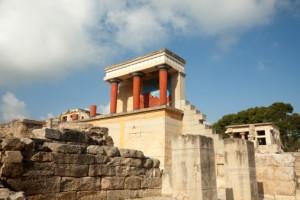Minoan civilization built by a European people, say researchers using DNA

One of the buildings at Knossos, the major civic center of the Minoans 5000 years ago, restored by British Archeologist Sir Arthur Evans.
The same people who built Europe built the bronze-age Minoan civilization, DNA analysis shows.
The first advanced Bronze-Age civilization, the Minoans of present-day Crete, was built by the descendants of the original settlers who had their greatest genetic similarity with modern European populations, according to a University of Washington study.
A team of researchers in the United States and Greece has used mitochondrial DNA analysis of Minoan skeletal remains to determine the likely ancestors of these ancient people.
Dr. George Stamatoyannopoulos, University of Washington professor of medicine and genome sciences, is the paper’s senior author. He believes that the data highlight the importance of DNA analysis as a tool for understanding human history.
“About 9,000 years ago,” he noted, “there was an extensive migration of Neolithic humans from the regions of Anatolia that today comprise parts of Turkey and the Middle East. At the same time, the first Neolithic inhabitants reached Crete.”
“Our mitochondrial DNA analysis shows that the Minoan’s strongest genetic relationships are with these Neolithic humans, as well as with ancient and modern Europeans,” he explained.
“These results suggest the Minoan civilization arose 5,000 years ago in Crete from an ancestral Neolithic population that had arrived in the region about 4,000 years earlier,” he said. “Our data suggest that the Neolithic population that gave rise to the Minoans also migrated into Europe and gave rise to modern European peoples.”
Stamatoyannopoulos and his research team analyzed samples from 37 skeletons found in a cave in Crete’s Lassithi plateau and compared them with mitochondrial DNA sequences from 135 modern and ancient human populations. The Minoan samples revealed 21 distinct mitochondrial DNA variations, of which six were unique to the Minoans and 15 were shared with modern and ancient populations. None of the Minoans carried mitochondrial DNA variations characteristic of African populations.
Further analysis showed that the Minoans were only distantly related to Egyptian, Libyan, and other North African populations. The Minoan shared the greatest percentage of their mitochondrial DNA variation with European populations, especially those in Northern and Western Europe.
When plotted geographically, shared Minoan mitochondrial DNA variation was lowest in North Africa and increased progressively across the Middle East, Caucasus, Mediterranean islands, Southern Europe, and mainland Europe. The highest percentage of shared Minoan mitochondrial DNA variation was found with Neolithic populations from Southern Europe.
Read the scientific paper
[Strangely, in our times we are unwisely reversing this migration pattern. Instead of high intelligence Europeans migrating and creating advanced civilizations, we are encouraging low-intelligence Semites and Black Africans to migrate and destroy these civilizations, at the same time allowing ourselves to perish. What's going on?]
Category
Ancient Aryan History, European History- 1172 reads










Comments
Greek statues
Ancient Greek (and Roman) statues all look pretty Nordic to me and Third Reich art resembles this style.
You are absolutely right on the wrong migration direction.
Its possible that skeletons
Its possible that skeletons are greek minotaurus sacrifices?
Im interesting for the difference betwen the chtonic and the sky gods like mircea eliade
Sorry for my english